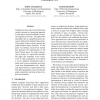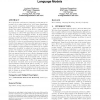80 search results - page 15 / 16 » Simple Features for Chinese Word Sense Disambiguation |
NAACL
2007
15 years 26 days ago
2007
Graph-based semi-supervised learning has recently emerged as a promising approach to data-sparse learning problems in natural language processing. All graph-based algorithms rely ...
74
Voted
ACL
2008
15 years 27 days ago
2008
We investigate the tasks of general morphological tagging, diacritization, and lemmatization for Arabic. We show that for all tasks we consider, both modeling the lexeme explicitl...
180
click to vote
CIKM
2011
Springer
13 years 11 months ago
2011
Springer
Word prediction performed by language models has an important role in many tasks as e.g. word sense disambiguation, speech recognition, hand-writing recognition, query spelling an...
114
click to vote
JMLR
2011
14 years 6 months ago
2011
We propose a framework MIC (Multiple Inclusion Criterion) for learning sparse models based on the information theoretic Minimum Description Length (MDL) principle. MIC provides an...
105
click to vote
RAS
2007
14 years 11 months ago
2007
This paper presents Scan-SLAM, a new generalisation of simultaneous localisation and mapping (SLAM). SLAM implementations based on extended Kalman filter (EKF) data fusion have t...


